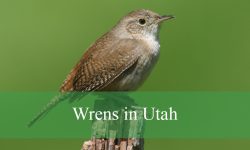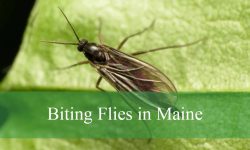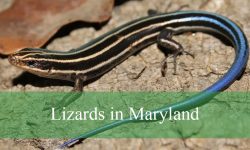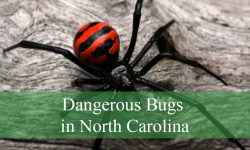Louisiana’s wetlands, swamps, and forests are home to an incredible variety of frogs. From tiny Spring Peepers to large Pig Frogs, each species adds to the state’s rich amphibian diversity.
Spring and early summer bring the peak of frog activity as rains fill ponds, marshes, and temporary pools. Their unique calls, ranging from high-pitched trills to deep grunts, echo across the wetlands and signal the breeding season.
Exploring forests, marshes, and pond edges reveals the fascinating behaviors and habitats of these amphibians. Observing their calls and movements provides a close look at the state’s vibrant wildlife.
Different Types of Frogs Found in Louisiana
American Green Tree Frog (Dryophytes cinereus)
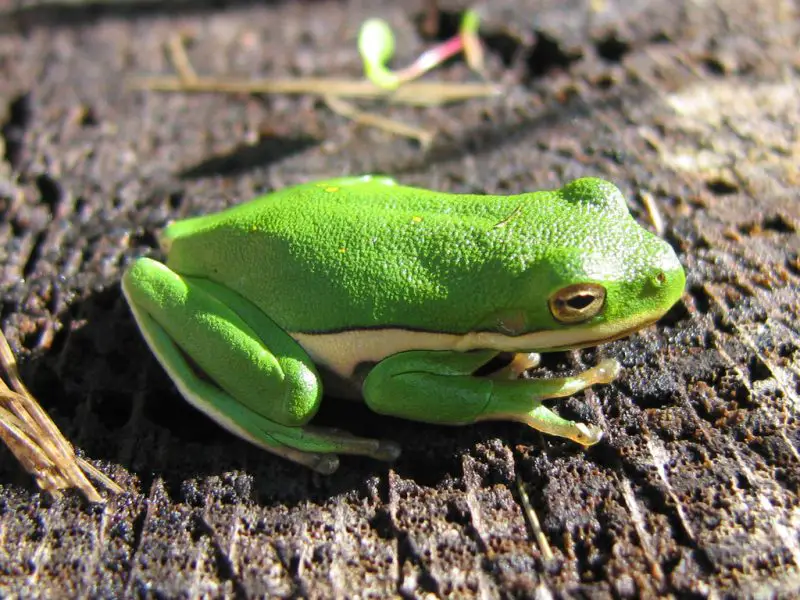
The American Green Tree Frog is a small, vibrant green frog, usually 1.25 to 2.0 inches in length. Its smooth skin and bright color make it easy to spot among the foliage. A distinctive white or yellow lateral stripe runs along each side of its body, which is a key identification feature. The toes are sticky and perfectly adapted for climbing leaves, branches, and even vertical surfaces.
These frogs are highly arboreal, spending much of their time in trees, shrubs, and tall grasses near water. They are most active during the warmer months, particularly in the spring and summer when humidity is high. Green Tree Frogs are generally nocturnal but can sometimes be seen during the day after rain.
Green Tree Frogs feed on insects and small invertebrates, including flies, beetles, and moths. Their diet helps control insect populations around wetlands and gardens. They use their sticky tongues to snatch prey quickly and efficiently.
The American Green Tree Frog produces a soft, nasal “quank” call that males use to attract females during the breeding season. These calls are most commonly heard in the evenings near ponds, ditches, and slow-moving streams. Despite their quiet size, their chorus can become surprisingly loud when many males gather together.
The best time to observe these frogs in Louisiana is from late spring to early summer. Areas such as bayous, marshes, and suburban ponds with abundant vegetation are ideal. Nighttime visits with a flashlight often reveal their bright green bodies clinging to leaves and reeds, making for excellent photography and observation opportunities.
Southern Leopard Frog (Lithobates sphenocephalus)
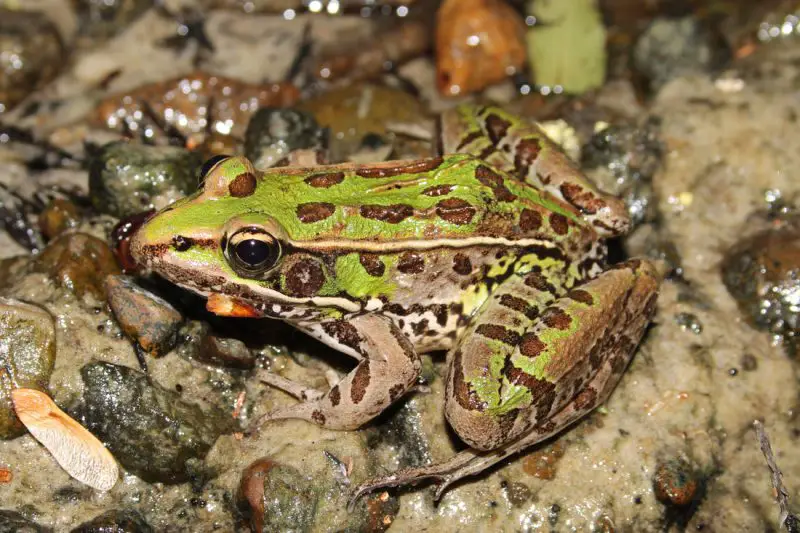
The Southern Leopard Frog is medium-sized, ranging from 2 to 4 inches long, with a slender body. Its green or brown skin is marked with dark, irregular spots outlined in lighter colors, giving it a “leopard” appearance. A prominent light stripe runs from the snout down the back, aiding in identification. Long, strong legs make it an excellent jumper.
These frogs are highly adaptable, inhabiting wetlands, ponds, streams, and even grassy meadows. They are active during the day and night but are most noticeable at night when calling for mates. Southern Leopard Frogs are known to migrate to temporary pools during breeding season, particularly after spring rains.
They are carnivorous, feeding on insects, spiders, and occasionally smaller frogs. Their hunting strategy combines stillness and sudden lunges, allowing them to capture prey efficiently. Their speed and agility make them difficult for predators to catch.
Males produce a series of short, snore-like calls repeated in a rhythmic sequence. These vocalizations are often heard during warm evenings and serve to attract females and establish territory. The chorus of leopard frogs can fill entire ponds with their sound.
In Louisiana, the best places to see Southern Leopard Frogs are marshes, pond edges, and grassy fields after rain. They are more visible in spring and early summer during breeding season. Observers often find them near shallow water or hopping among wet grasses.
Pig Frog (Lithobates grylio)
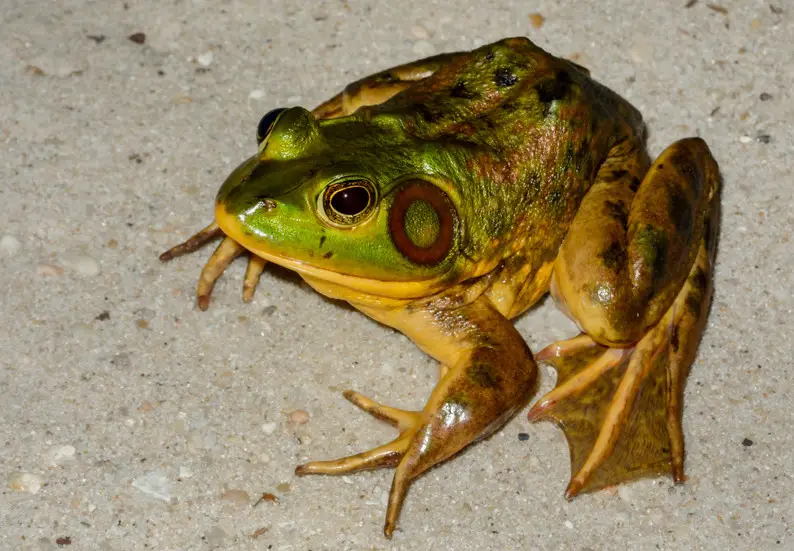
Pig Frogs are large and heavy-bodied, typically 4 to 6 inches long, with a wide, flat head. Their olive-gray or brown skin is covered in irregular dark spots. They are highly aquatic, with webbed hind feet designed for swimming. The eyes are prominent, giving them a characteristic “alert” look, and they can be intimidating in size compared to smaller frogs.
Pig Frogs are primarily nocturnal and spend most of their time in permanent water bodies such as swamps, lakes, rivers, and ponds. During the day, they often hide among vegetation or submerged in shallow water to avoid predators. These frogs are strong swimmers and rarely leave the water for extended periods.
Their diet consists mostly of insects, crustaceans, small fish, and occasionally other frogs. Pig Frogs are opportunistic feeders and can capture prey near the water surface or underwater. Their large mouths allow them to consume relatively large food items compared to other frog species.
The Pig Frog’s call is a deep, resonant grunt resembling a pig’s oink, which gives the species its common name. Males call from floating vegetation or water edges during the breeding season, creating a chorus that can carry across large areas of a swamp.
The best time to observe Pig Frogs in Louisiana is during late spring and summer nights. Swamps, ponds, and slow-moving rivers with dense aquatic vegetation are ideal. Patience and quiet observation near the water’s edge are key to spotting these mostly hidden but vocal amphibians.
Crawfish Frog (Lithobates areolatus)
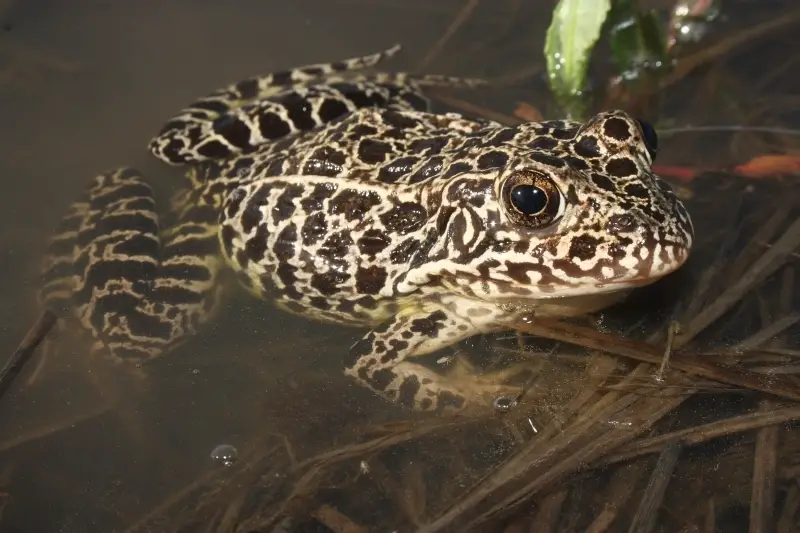
Crawfish Frogs are medium-sized, ranging from 2.5 to 4 inches long, with tan to brown skin marked by dark spots. Their mottled pattern helps them blend into sandy soils near wetlands. A notable feature is their association with crayfish burrows, which provide shelter and protection from predators.
These frogs spend most of the year underground inside crayfish burrows, emerging primarily during the breeding season. They prefer temporary wetlands in prairies, grasslands, and sandy areas. Their reliance on burrows makes them somewhat elusive compared to more visible frog species.
Crawfish Frogs feed on insects, spiders, and other invertebrates that come near their burrow entrances. Their hunting strategy involves waiting at the burrow’s opening and quickly lunging at passing prey.
The male’s call is a deep, hollow “woop” repeated in sequences, often heard during spring rains. Breeding typically occurs in temporary ponds, and males establish territories near the water’s edge. Listening for their calls is the easiest way to locate them, given their secretive nature.
The ideal time to observe Crawfish Frogs in Louisiana is early spring, especially after heavy rainfall. Look for them in prairie wetlands and temporary pools in central and northern parts of the state. Daytime observation is rare; evening or night is best.
Southern Chorus Frog (Pseudacris nigrita)
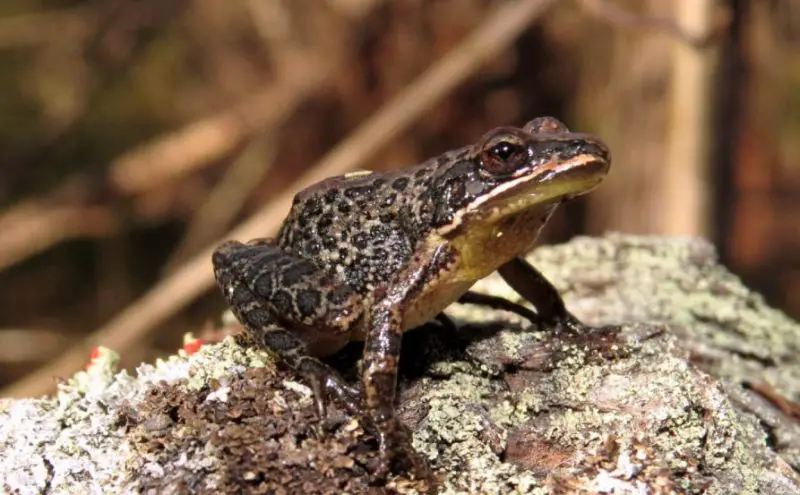
Southern Chorus Frogs are tiny, usually 0.75 to 1.5 inches in length, with smooth brown or gray skin. They have three distinct dark stripes running down the back and often a lighter stripe along the side. Their small size and camouflage make them difficult to spot, but their vocalizations are unmistakable.
These frogs inhabit grassy areas, marshes, and temporary ponds. They are highly dependent on seasonal rainfall for breeding. Southern Chorus Frogs are mostly nocturnal and can often be found calling in large choruses after rain.
Their diet consists primarily of small insects, including ants, flies, and beetles. Despite their tiny size, they are efficient predators, capturing prey with quick, precise movements.
The male’s call is a rapid, high-pitched trill repeated for several seconds. Choruses are often so loud they can be heard from a distance, signaling the start of breeding season. These calls are usually heard in late winter to early spring.
The best observation period in Louisiana is after heavy rains in late winter and early spring. Temporary pools, grassy wetlands, and roadside ditches are prime locations. Observers should focus on listening for their calls at night to locate these small but vocally active frogs.
Wood Frog (Lithobates sylvaticus)
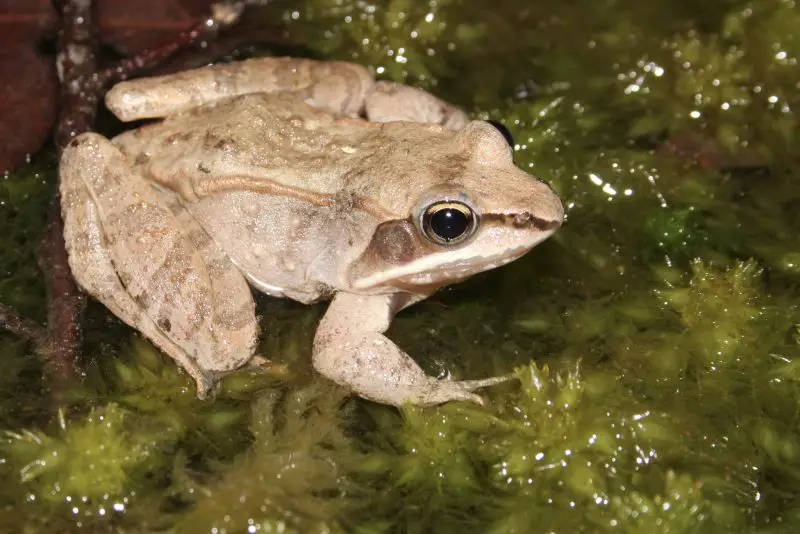
Wood Frogs are medium-sized, ranging from 1.5 to 3 inches in length, with tan, brown, or rust-colored skin. A distinct dark mask runs across each eye, giving them a “bandit” appearance. Their bodies are smooth, and they have long, strong legs for jumping. Unlike many frogs, they are adapted to cooler environments and temporary woodland pools.
These frogs are mostly found in forested wetlands, vernal pools, and along pond edges. They are active in early spring and are known to emerge as soon as snow melts in northern parts of their range, though in Louisiana they appear with early spring rains. Wood Frogs spend much of the year hidden under leaf litter and forest debris.
Wood Frogs feed on insects, spiders, and other small invertebrates. They are opportunistic predators, capturing prey with their sticky tongues. Because of their woodland habitat, their diet often includes insects that live in leaf litter or near temporary pools.
The male’s call is a short, nasal “quack” similar to a duck, repeated in choruses during the breeding season. These calls are typically heard during the day or night in early spring. Wood Frogs often gather in large numbers in temporary pools to mate.
In Louisiana, the best time to see Wood Frogs is in early spring, particularly in forested areas with vernal pools. Observers should look among leaf litter or at the edges of temporary ponds. Their sudden appearance after rains makes spring an ideal time for both spotting and listening to their calls.
Spring Peeper (Pseudacris crucifer)
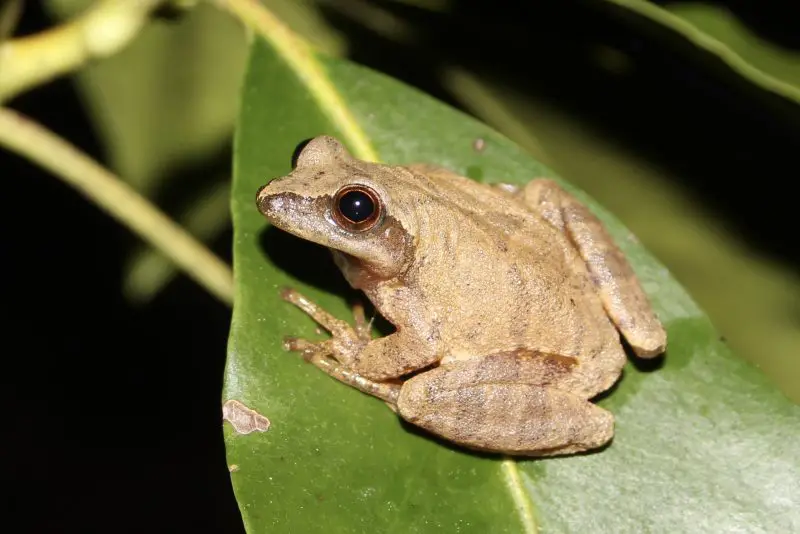
Spring Peepers are tiny frogs, usually about 1 inch long, with tan or light brown bodies marked by a dark X-shaped pattern on the back. Their small size and camouflaged skin make them difficult to spot, but they are extremely vocal during the breeding season. Long toes and adhesive pads allow them to climb shrubs and low vegetation.
These frogs inhabit wetlands, shallow ponds, and grassy lowlands. They are among the earliest frogs to emerge in spring, often appearing as soon as ice melts or temperatures rise above 40°F. Spring Peepers spend most of the year hidden under leaves, bark, or soil.
They feed mainly on ants, spiders, and small insects. Their small mouths suit tiny prey, and they hunt mostly at night. Despite their size, they are efficient predators in wetland ecosystems.
Male Spring Peepers produce a high-pitched, whistling “peep” that can be heard over long distances. During peak breeding season, their choruses create an almost continuous background sound near ponds and marshes. This makes them easy to locate even when hidden from view.
The best time to observe Spring Peepers in Louisiana is from late February to April. Wetlands, ditches, and pond edges are prime locations, especially during rainy evenings. Their small size requires patience, but listening for their calls often leads to successful sightings.
Southern Leopard Frog (Lithobates utricularius)

The Southern Leopard Frog is a larger subspecies of the common leopard frog, measuring 2.5 to 4 inches. Its bright green or brown skin is marked with large, dark spots, and it has long, powerful legs for jumping. A light-colored dorsal stripe is present, often more pronounced than in northern counterparts.
They are highly aquatic, favoring rivers, ponds, swamps, and marshes. These frogs are excellent swimmers and are usually found near permanent water sources. Breeding occurs in spring and early summer, often in shallow, vegetated pools.
Southern Leopard Frogs feed on insects, small fish, and other amphibians. They are opportunistic hunters, lunging quickly at passing prey. Their diet makes them an important predator in wetland ecosystems.
Males produce a rhythmic, snore-like call, repeated in choruses during breeding. These calls are usually heard in the evenings near ponds and marshes. Large groups of calling males create a rich, continuous soundscape.
In Louisiana, they are best observed in spring and summer along pond edges, marshes, and slow-moving rivers. Quiet observation near shallow water or among reeds increases chances of spotting these active and agile frogs.
Green Frog (Lithobates clamitans)
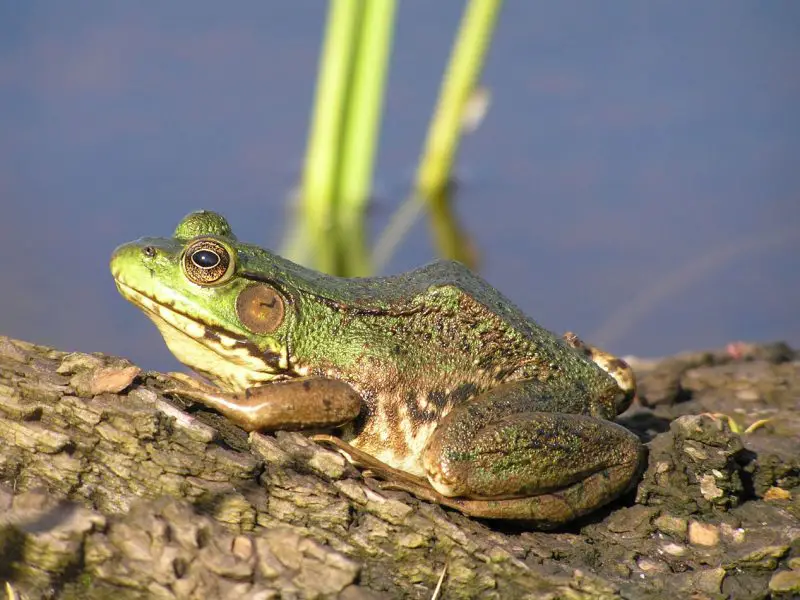
Green Frogs are medium to large frogs, measuring 2 to 4 inches in length. Their skin ranges from green to brown with dorsolateral ridges running from the eyes down the back. They have strong legs and webbed feet, which make them proficient swimmers. Males are slightly smaller and may appear brighter during breeding season.
They inhabit lakes, ponds, rivers, and marshes throughout Louisiana. Green Frogs are semi-aquatic, often seen sitting on lily pads or partially submerged near the water’s edge. They are active day and night but become more vocal during warm evenings in spring and summer.
Green Frogs feed on insects, spiders, small fish, and other amphibians. They are opportunistic predators and rely on both ambush and active hunting techniques. Their presence helps control populations of various aquatic and semi-aquatic invertebrates.
Males produce a distinctive “banjo-like” call, a series of low-pitched plucks repeated rapidly. This call is most prominent during mating season, creating a lively chorus across ponds and marshes.
The best time to observe Green Frogs in Louisiana is late spring through summer, especially in freshwater ponds and marshes. They are easily spotted sitting on vegetation near water or swimming just below the surface. Evening visits are ideal for hearing their calls.
Bronze Frog (Lithobates clamitans clamitans)
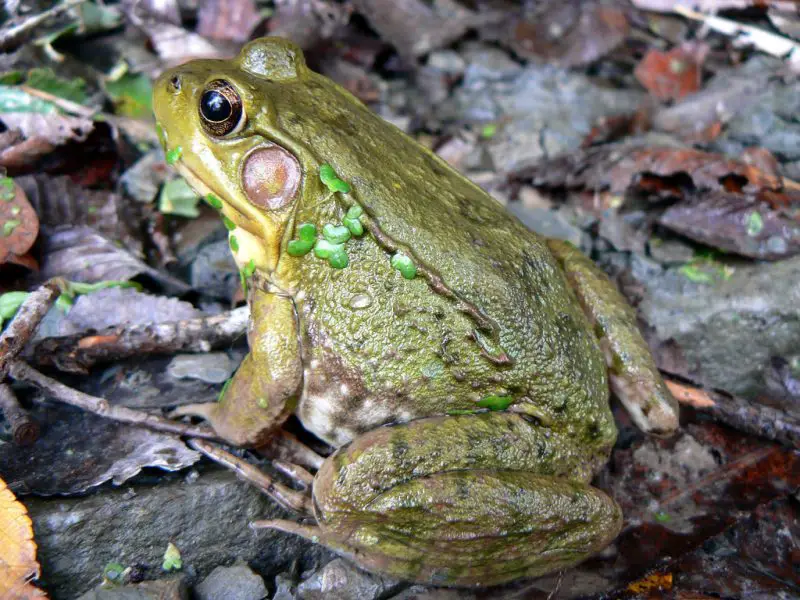
Bronze Frogs are a subspecies of the Green Frog, typically slightly smaller, 2 to 3.5 inches long. Their coloration is a dark bronze to olive-brown, often with lighter underbellies. They have dorsolateral ridges and long legs suited for jumping and swimming.
These frogs prefer southern swamps, ponds, and vegetated streams in Louisiana. They are semi-aquatic and spend most of their time near the water, hiding in dense vegetation to avoid predators. They are active both day and night, but males are especially vocal at dusk.
Their diet includes insects, spiders, and smaller amphibians. Bronze Frogs are ambush predators, waiting quietly in vegetation before striking prey with rapid tongue movements.
Males call with a resonant, low-pitched “plunk” or “banjo-like” sound similar to Green Frogs but slightly deeper. Breeding season typically occurs in late spring and early summer, and males congregate in groups near water to call for mates.
The best observation period in Louisiana is late spring to early summer in swamps, marshes, and pond edges. Patience and quiet observation near aquatic vegetation yield the highest chance of spotting these camouflaged but vocally active frogs.
Gray Tree Frog (Dryophytes versicolor)
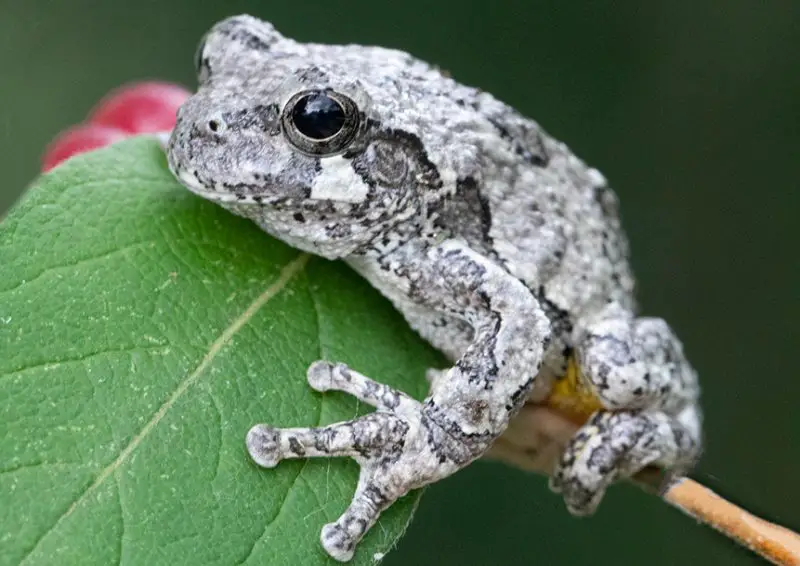
Gray Tree Frogs are small, usually 1.25 to 2 inches long, and exhibit remarkable color-changing ability, ranging from gray to green depending on temperature and surroundings. Their skin is warty or slightly rough, providing excellent camouflage among tree bark and leaves. They have adhesive toe pads that allow them to climb vertical surfaces with ease.
These frogs are primarily arboreal and are found in forests, woodlands, and near wetlands. They often perch in trees, shrubs, or even on buildings near ponds and streams. Gray Tree Frogs are mostly nocturnal but can occasionally be seen during daytime after rain.
They feed on insects and other small invertebrates, including beetles, moths, and spiders. Their hunting technique involves remaining still and ambushing prey with rapid tongue strikes. They play an important role in controlling insect populations in forests and gardens.
Male Gray Tree Frogs produce a long, musical, trilling call that can last several seconds. This call is used to attract females and establish territory. Choruses are common during late spring and summer nights, creating a rich soundscape in wooded wetlands.
The best time to observe Gray Tree Frogs in Louisiana is late spring through summer, especially at night near ponds, lakes, and wetlands. Flashlights often reveal them clinging to tree trunks, leaves, or even walls, their coloration blending perfectly with the surroundings.
Pickerel Frog (Lithobates palustris)
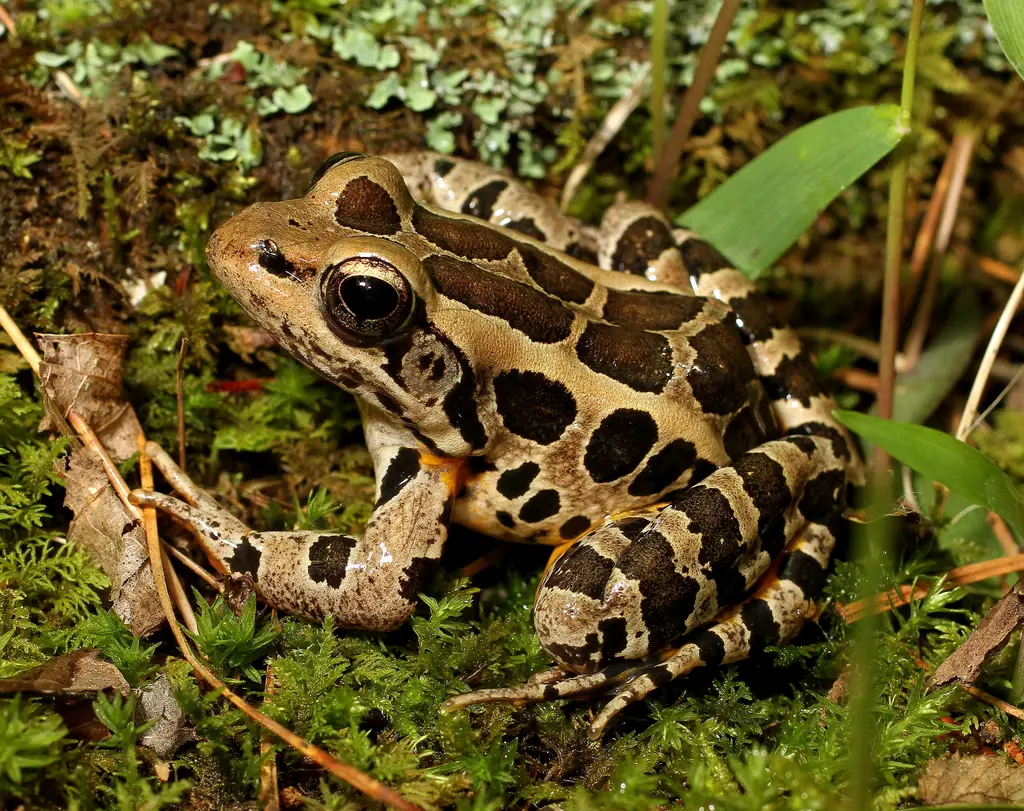
Pickerel Frogs are medium-sized, usually 2 to 3 inches long, with brown or tan bodies featuring two parallel rows of dark rectangular spots running down the back. Their skin is smooth, and they have long, powerful legs. They can be confused with leopard frogs but are distinguished by the square shape of their spots.
These frogs are semi-aquatic and inhabit cool streams, marshes, and ponds. They prefer clear, shallow water with abundant vegetation for cover. Pickerel Frogs are mostly nocturnal but may also be active during the day in moist conditions.
Pickerel Frogs feed on insects, spiders, and small aquatic organisms. They are unique among frogs in producing mild skin toxins that deter some predators, such as snakes. Their ambush hunting strategy involves remaining motionless and striking suddenly.
The male’s call is a low, snore-like “unk-unk-unk” repeated rhythmically. This call is used to attract females during spring and early summer. Choruses can be found along pond edges, stream banks, and wet meadows.
In Louisiana, the best observation time is spring and early summer along shaded streams, ponds, and marshes. Look for them partially submerged or hidden in vegetation. Their camouflage and secretive behavior make listening for calls essential to locating them.
Cope’s Gray Tree Frog (Dryophytes chrysoscelis)
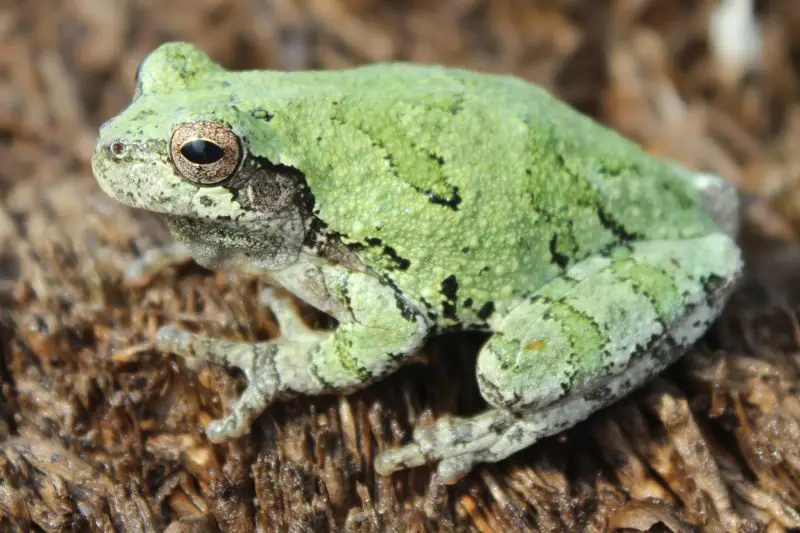
Cope’s Gray Tree Frogs are small, about 1.25 to 2 inches long, and highly similar in appearance to Gray Tree Frogs. They have gray to green skin with darker mottling and can change color to blend with their surroundings. Adhesive toe pads allow them to climb trees, shrubs, and walls with ease.
These frogs inhabit forests, wetlands, and areas near ponds. They are arboreal and spend most of their time perched on vegetation. Cope’s Gray Tree Frogs are nocturnal, becoming active during warm, humid evenings, especially after rainfall.
Their diet includes insects, spiders, and other small invertebrates. They are ambush predators, waiting quietly before striking quickly with their sticky tongues. These frogs help control insect populations in both natural and suburban areas.
Male Cope’s Gray Tree Frogs produce a rapid, high-pitched trill similar to Gray Tree Frogs but faster. These calls are used to attract females and establish territory during the breeding season. Choruses are common in late spring and summer.
The best time to observe Cope’s Gray Tree Frogs in Louisiana is late spring through summer, especially at night near ponds, wetlands, or wooded areas. They are often found clinging to tree trunks, shrubs, or even human structures, their coloration blending seamlessly with bark and leaves.
Southern Cricket Frog (Acris gryllus)
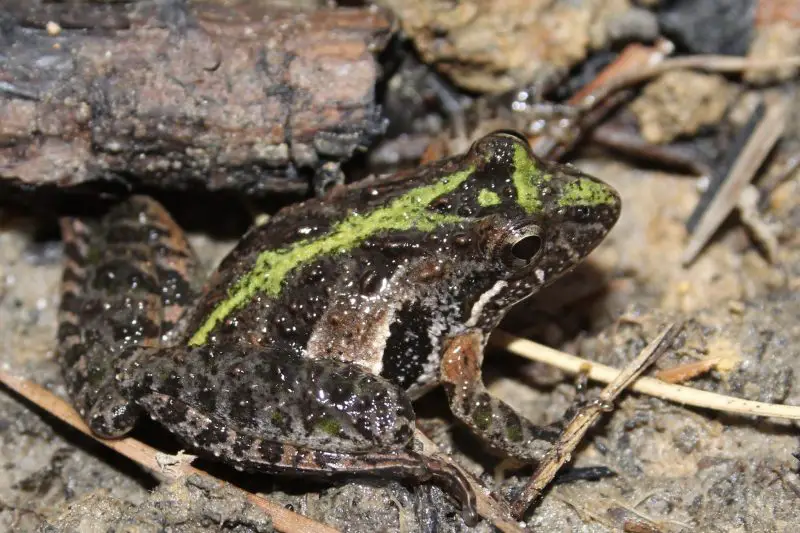
Southern Cricket Frogs are tiny, about 0.75 to 1.25 inches long, with rough, warty skin. Their coloration varies from gray to brown or green, with dark stripes on their legs. These frogs are incredibly agile and can jump several feet in a single leap despite their small size.
They prefer grassy wetlands, marsh edges, and the shallow margins of ponds and streams. Southern Cricket Frogs are diurnal and nocturnal, often seen hopping quickly across vegetation or floating on water surfaces. They are highly sensitive to changes in water levels and temperature.
Their diet mainly includes small insects such as flies, mosquitoes, and midges. They are ambush predators, waiting motionless before leaping at unsuspecting prey. Despite their tiny size, they are important insect predators in wetland ecosystems.
Males produce a sharp, high-pitched “gick-gick-gick” call, which resembles the sound of a cricket. This vocalization is repeated in rapid succession during breeding season and is often the easiest way to locate these frogs.
In Louisiana, the best observation period is spring and summer. They are easiest to find near the shallow edges of ponds, marshes, and wet grasslands. Listening for their distinctive cricket-like calls helps pinpoint their location before spotting them visually.
Ornate Chorus Frog (Pseudacris ornata)
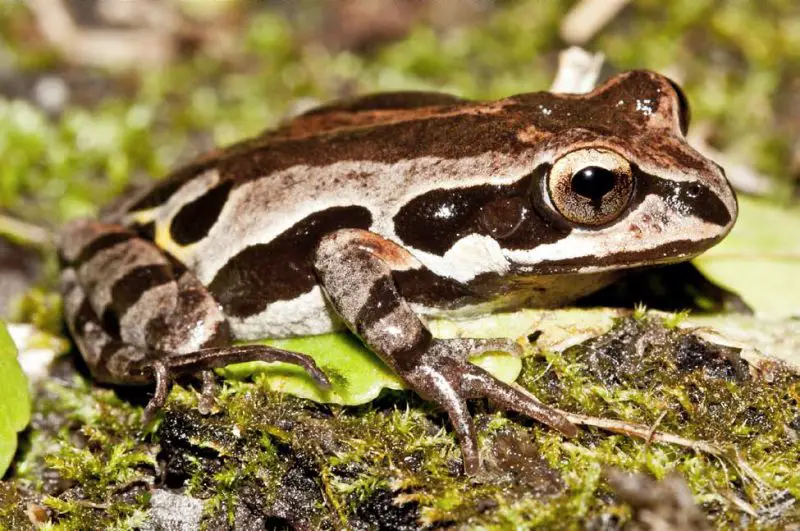
Ornate Chorus Frogs are small, typically 1 to 1.5 inches long, with brown or tan skin marked by irregular dark stripes or spots. Their smooth skin and subtle patterning allow them to blend into grass, leaf litter, and shallow wetland areas. They are highly vocal during breeding season.
These frogs inhabit grassy wetlands, temporary pools, and open fields. They rely on seasonal rainfall to fill ephemeral pools for breeding. Outside the breeding season, they are often hidden under vegetation or burrow slightly into moist soil.
Ornate Chorus Frogs feed on ants, small beetles, and other tiny insects. They hunt mainly by ambush, waiting motionless before lunging at passing prey with their sticky tongues. Their small size requires precise and quick feeding movements.
Males produce a fast, high-pitched trill, often repeated continuously during mating season. Choruses can be heard across flooded fields and grasslands, creating a lively springtime soundscape. Their vocalizations make them easier to locate than to see.
The best time to observe Ornate Chorus Frogs in Louisiana is after heavy rains in late winter and spring. Temporary pools, flooded fields, and grassy wetlands are prime locations. Nighttime observation is ideal, using their calls to locate them before seeing their tiny bodies.
Gulf Coast Leopard Frog (Lithobates sphenocephalus utricularius)
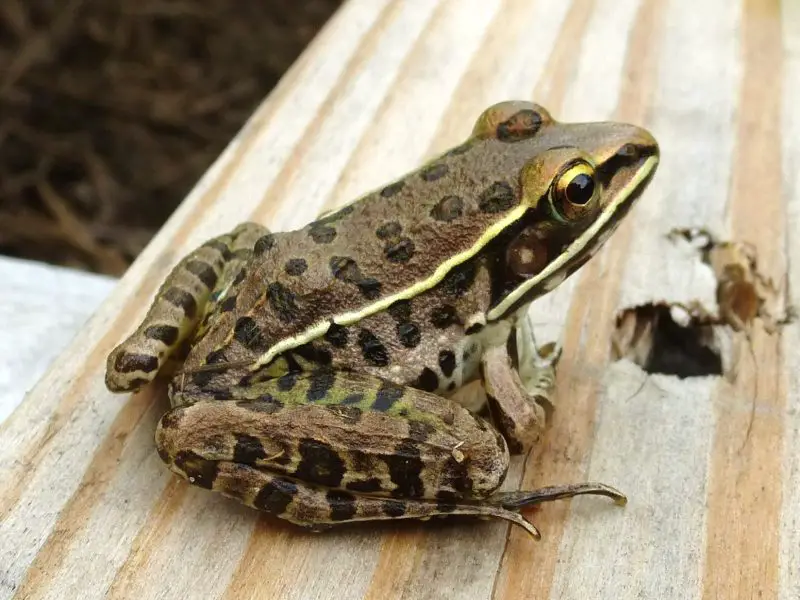
Gulf Coast Leopard Frogs are a subspecies of the Southern Leopard Frog, measuring 2.5 to 4 inches. They have bright green to brown skin with large, dark spots outlined in light coloring. Their dorsal stripe is often more prominent than in northern leopard frogs, aiding identification.
These frogs are highly aquatic, preferring swamps, ponds, rivers, and marshes. They are strong swimmers and remain close to permanent water bodies, often hidden in aquatic vegetation. They are active both day and night but are especially visible near shallow water edges.
Gulf Coast Leopard Frogs feed on insects, smaller frogs, and other invertebrates. They are opportunistic predators, lunging quickly at prey with long, powerful legs. Their diet helps regulate insect and amphibian populations in wetland ecosystems.
Males produce a rhythmic, snore-like call during the breeding season. Choruses of males can fill marshes and pond edges with their repetitive vocalizations, especially during spring and early summer. These calls are one of the easiest ways to locate them.
The best time to observe Gulf Coast Leopard Frogs in Louisiana is spring and early summer, particularly along pond edges, marshes, and swamps. Quiet observation near shallow water or among reeds provides the highest chance of spotting these active amphibians.
Squirrel Tree Frog (Dryophytes squirellus)
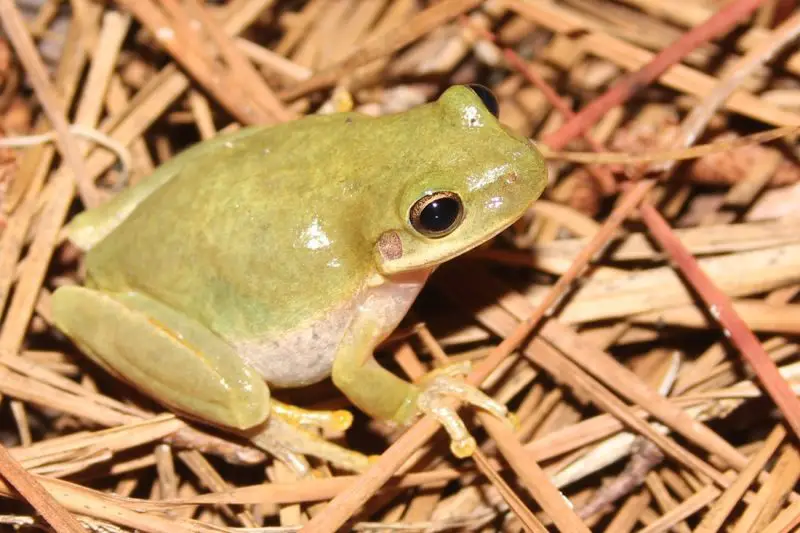
Squirrel Tree Frogs are small, usually 1 to 1.5 inches, with green, yellow, or brown bodies often marked with reddish or gold highlights. They have smooth skin and adhesive toe pads for climbing trees, shrubs, and even man-made structures. Their coloration is highly variable, allowing effective camouflage.
These frogs inhabit forests, swamps, and suburban gardens near wetlands. They are arboreal and spend most of their time perched on vegetation. Squirrel Tree Frogs are nocturnal and most active during warm, humid nights, especially after rain.
Their diet includes small insects, spiders, and other invertebrates. They are agile hunters, capturing prey with quick tongue strikes. Their feeding habits help control insect populations in both natural and urban habitats.
Males produce a rapid, high-pitched “squeak” or “trill” during breeding season. Choruses occur at night near ponds, ditches, or wetland edges, creating a lively acoustic environment. These calls are key to locating them since their small size makes visual spotting difficult.
The best time to observe Squirrel Tree Frogs in Louisiana is late spring through summer, especially on warm nights after rainfall. Look for them clinging to tree trunks, shrubs, or garden vegetation, where their coloration blends seamlessly with the surroundings.
FAQs about Frogs in Louisiana
What is the best time of year to see frogs in Louisiana?
The best time to observe frogs in Louisiana is during the spring and early summer months, typically from March through June. This period coincides with breeding season when frogs are most active and vocal. Warm, rainy nights are ideal for spotting both arboreal and aquatic species near ponds, marshes, and wetlands.
Where are the most common places to find frogs in Louisiana?
Frogs are commonly found near freshwater habitats, including ponds, lakes, marshes, swamps, streams, and rivers. Arboreal species, like tree frogs, are often seen perched on vegetation, shrubs, or trees near water. Some terrestrial species, like Crawfish Frogs, may also be found in prairie wetlands or grassy areas.
How can I identify different frog species in Louisiana?
Frog identification typically involves observing size, coloration, patterns, and unique markings. Vocalizations are also an important clue, as many species have distinct calls. For example, Pig Frogs produce deep grunts, while Spring Peepers emit high-pitched whistles. Seasonal activity and habitat can further narrow down species identification.
Are any frogs in Louisiana poisonous or dangerous?
Most frogs in Louisiana are harmless to humans. However, some species, like Pickerel Frogs, secrete mild skin toxins that can irritate the skin or deter predators. Gulf Coast Toads and Woodhouse’s Toads have parotoid glands that produce toxins if handled, so it’s best to observe rather than touch them.
What should I do if I want to hear frog calls?
To hear frog calls, visit ponds, marshes, or wetlands during warm, humid evenings, especially after rainfall. Sit quietly near the water’s edge or vegetation and listen for choruses. Each species has a distinctive call, ranging from the high-pitched peeps of Spring Peepers to the low grunts of Pig Frogs.
Can frogs be found in urban areas of Louisiana?
Yes, many frog species adapt to urban and suburban environments. Tree frogs, Green Frogs, and Gulf Coast Toads can often be found in gardens, yards, parks, and drainage ditches. Access to water sources and vegetation increases the likelihood of seeing frogs in city or suburban settings.
How can I safely observe frogs without harming them?
To safely observe frogs, avoid handling them whenever possible, as their skin is sensitive. Use binoculars or a flashlight for better viewing, especially at night. Stay on trails or edges of wetlands to prevent habitat disturbance, and avoid polluting water sources. Observing quietly and from a distance ensures the frogs remain undisturbed.

